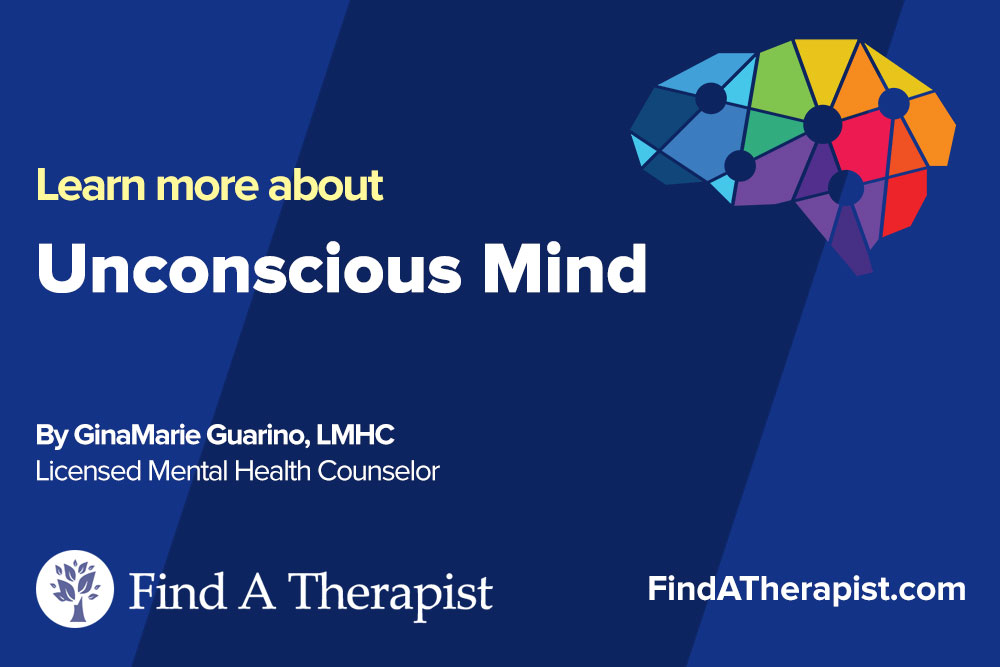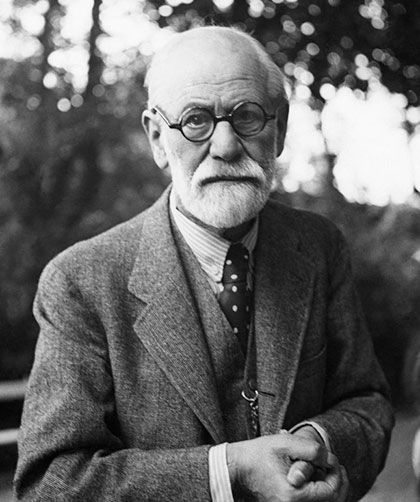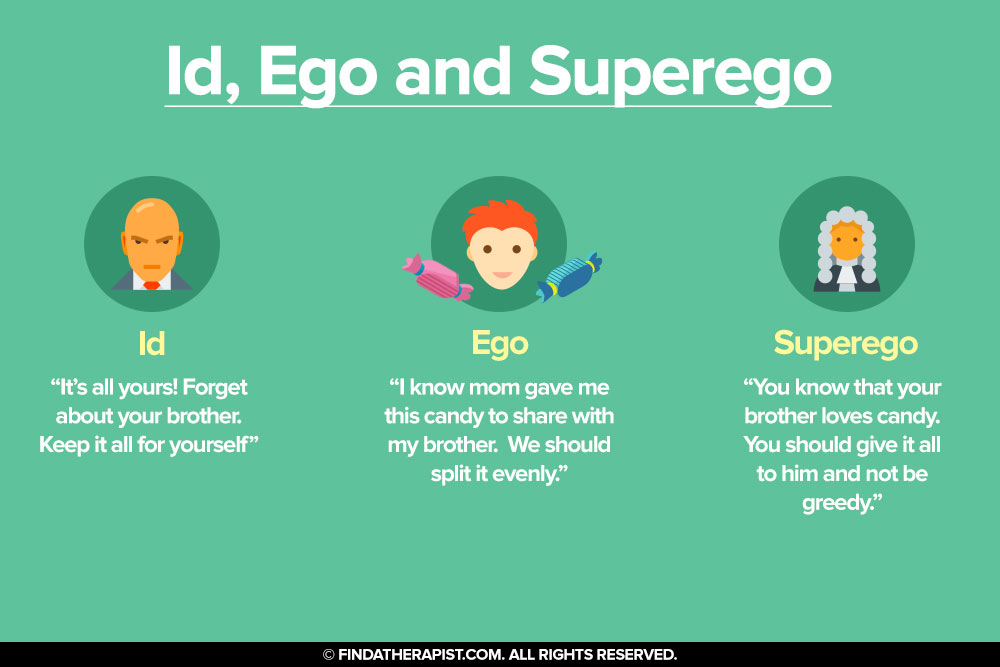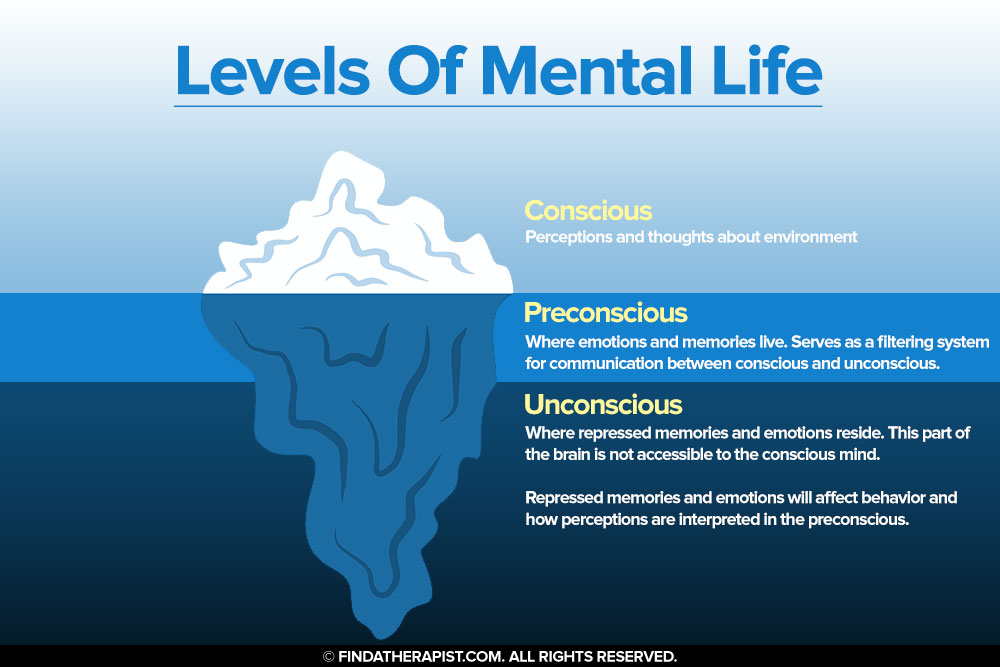Unconscious Mind
Published on December 11th, 2019
Updated on January 2nd, 2024

Sigmund Freud is the creator of the first theory about the unconscious mind. His theory is called psychoanalysis. Psychoanalysis focuses on how unconscious drives affect behavior. Freud believed that most conscious thoughts and impulses derive from the unconscious. According to Freud, the mind consists of three levels:
- The Unconscious Mind
- The Preconscious Mind
- The Conscious Mind

Each level is located in different depths of the mind. The unconscious mind is the deepest and darkest place of the mind. The preconscious mind is what sits below the surface of consciousness. The conscious mind is responsible for conscious awareness.
Sponsored by

Choose a therapist to work with and start healing with 20% off from BetterHelp.
Click HereThe unconscious mind, preconscious mind and conscious mind all have their own purpose. They all affect each other and communicate with each other. Each of the three levels plays an integral role in:
- Memory
- Personality
- The ability to cope with stress
Freud believed that the unconscious mind powers motivation and human behavior. According to Freud’s theory, a person has little awareness of where their motivation comes from. They do not realize how their unconscious affects them.
With psychoanalysis, the goal is often to bring unconscious drives to awareness. Understanding the core of unconsciousness helps a person understand why they think and behave the way they do. They learn about where different parts of their reactions and personality come from.
The id, ego and superego significantly contribute to the different levels of the mind. The levels of the mind work with the id, ego and superego to process information. This process contributes to the generating of responses and reactions to external reality.

The Unconscious Mind
Contributions from: The Id and Superego
The unconscious mind is responsible for a person’s motivations for behavior. It is also responsible for human instinct. All feelings, reactions and behaviors stem from the work of the unconscious mind.
Freud believed that people are capable of making conscious decisions for their behavior. They are aware of how they are reacting to stressors.
Even though people are capable of making conscious decisions, they are not aware of where their initial impulses began. They also do not know how the impulses developed and moved into consciousness.
Memories, desires and repressed impulses are stored deep within the unconscious mind. Even though they are in the unconscious mind, they contribute to how a person feels, thinks and behaves.
The id is housed in the unconscious mind. It is responsible for primitive drives for survival.
The core of a person’s personality comes from the id. It is fueled by the pleasure principle. The pleasure principle ensures that human desires and needs are met.
Since the id is housed deep in the unconscious mind, it is not connected with reality or life outside of the body. It is solely concerned with preserving the self.
The superego is also active in the unconscious mind. Moral principles, social initiative, and the conscience all reside in the unconscious mind. Each of these components of the superego affect how the unconscious mind operates.
The Preconscious Mind
Contributions from: The Ego and Superego
The preconscious mind lies between the unconscious mind and the conscious mind. It is the space in the middle that is responsible for communication between each side. Unconscious thoughts, feelings and impulses must pass through the preconscious mind. The preconscious mind decides what reaches consciousness. The preconscious mind serves as a barrier, that filters what becomes conscious to a person.
Conscious information is also transferred to the unconscious mind through the preconscious mind. The preconscious mind serves as a two-way transfer station. It is responsible for deciding what information reaches each end of consciousness.
The goal of the preconscious is to minimize emotional distress. In order to do so, the preconscious mind may reform, reconfigure or re-arrange information from each side, so it feels less stressful. If the information activates less stress for the person, it will cause less emotional distress. This will create fewer long term consequences. It also ensures that the id, ego and superego are satisfied.
Both the ego and the superego are active in the preconscious mind. The ego allows for reality testing and processing of information from consciousness. The superego contributes to taking in considerations from the person’s moral code.
The Conscious Mind
Contributions from: The Ego and Superego
The conscious mind consists of present awareness. It is the information we receive from our environment. Conscious awareness is the first part of the mind that receives and interprets information from the outside world. It is also where decisions, thoughts and behaviors are put into action.
The ego and superego are active in the conscious mind. The preconscious mind uses input from the ego and superego. This occurs when it is transferring information from the unconscious mind to the conscious mind. The ego is responsible for finding balance between the id and superego. The superego is responsible for maintaining moral and social code. This occurs when making decisions, choosing words, and determining reactions to the environment.
How The Levels Of The Mind Work Together

Preconscious information is transferred from the unconscious mind to the conscious mind. A great example of how each level of the mind works together is illustrated through the expression of feelings.
The conscious mind is also responsible for expression of feelings. Feelings can be complicated. They come from the unconscious mind, but are always filtered through the preconscious mind. Then, the feelings are transferred to conscious mind.
A great example is when someone experiences rejection. Rejection is an experience that causes negative emotions. When a person is rejected by another person, they feel sad and embarrassed. These feelings comes from the unconscious mind, and can be too painful for the conscious mind. As a result, the preconscious mind may turn the feeling of sadness and embarrassment into anger.
Anger is easier to feel because it is less vulnerable. It also serves as a protection against the deeper emotions. By the time the feelings of sadness and embarrassment reach the conscious mind, they have been reconfigured to manifest as anger.
In this example, the three levels of the mind worked together. The conscious mind transferred the rejection to the unconscious mind. In response, the unconscious mind activated feelings of anger and embarrassment. The unconscious mind sent the feelings back to the conscious mind.
The preconscious mind filtered the feelings. It determined that these feelings are too painful for the conscious mind to cope with. It turned the sadness and embarrassment into anger. Once the feelings were reconfigured to anger, the preconscious mind transferred the conscious mind to feel angry.
Sponsored by

Find an affordable therapist online with 20% off from BetterHelp.
Click Here






Leave A Reply